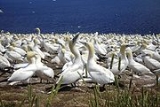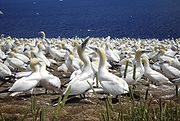
Bonaventure Island
Encyclopedia

Canada
Canada is a North American country consisting of ten provinces and three territories. Located in the northern part of the continent, it extends from the Atlantic Ocean in the east to the Pacific Ocean in the west, and northward into the Arctic Ocean...
island in the Gulf of St. Lawrence located 3.5 kilometres (2.2 mi) off the southern coast of Quebec
Quebec
Quebec or is a province in east-central Canada. It is the only Canadian province with a predominantly French-speaking population and the only one whose sole official language is French at the provincial level....
's Gaspé Peninsula
Gaspé Peninsula
The Gaspésie , or Gaspé Peninsula or the Gaspé, is a peninsula along the south shore of the Saint Lawrence River in Quebec, Canada, extending into the Gulf of Saint Lawrence...
, 5 kilometres (3.1 mi) southeast of the village of Percé
Percé, Quebec
Percé is a small village near the tip of the Gaspé Peninsula in Québec. As a municipality, it is 432.39 square km in area. It has a long history of being an important seasonal fishing centre under the French...
. Roughly circular in shape, it has an area measuring 4.16 square kilometres (1.6 sq mi).
History
Bonaventure Island (Île Bonaventure), with Percé, was among the early seasonal fishing ports of New FranceNew France
New France was the area colonized by France in North America during a period beginning with the exploration of the Saint Lawrence River by Jacques Cartier in 1534 and ending with the cession of New France to Spain and Great Britain in 1763...
, and was associated with the lineage of Nicolas Denys
Nicolas Denys
.Nicolas Denys was a French aristocrat who became an explorer, colonizer, soldier and leader in New France. Today, he is perhaps best known for founding settlements at St. Pierre , Ste...
. The island became a migratory bird sanctuary in 1919 due to the 1916 Migratory Bird Convention between Canada and the United States. The Province of Quebec acquired ownership of the entire island in 1971 and later grouped it together with Percé Rock
Percé Rock
Percé Rock is a huge sheer rock formation in the Gulf of Saint Lawrence on the tip of the Gaspé Peninsula in Quebec, Canada, off Percé Bay. Percé Rock appears from a distance like a ship under sail. It is one of the world's largest natural arches located in water and is considered a natural icon...
into the Parc national de l'île-Bonaventure-et-du-Rocher-Percé (Bonaventure Island and Percé Rock National Park) in 1985. One of the largest and most accessible bird sanctuaries in the world, with more than 280,000 birds, Bonaventure Island is a major tourist destination
Tourist destination
A tourist destination is a city, town, or other area that is dependent to a significant extent on the revenues accruing from tourism. It may contain one or more tourist attractions and possibly some "tourist traps."...
with boat and island tours from May to October.
The aircraft carrier HMCS Bonaventure was named after the island.
Birds
293 different species of birds have been recorded as visiting, migrating to, or living on Bonaventure island.The most common bird found on the island is the Northern Gannet
Northern Gannet
The Northern Gannet is a seabird and is the largest member of the gannet family, Sulidae.- Description :Young birds are dark brown in their first year, and gradually acquire more white in subsequent seasons until they reach maturity after five years.Adults are long, weigh and have a wingspan...
. The island is home to the largest colony of gannets in the world, with over 121,000 birds.
Other populous colonies include the Black-legged Kittiwake
Black-legged Kittiwake
The Black-legged Kittiwake is a seabird species in the gull family Laridae.This species was first described by Linnaeus in his Systema naturae in 1758 as Larus tridactylus....
and the Common Murre. Tern
Tern
Terns are seabirds in the family Sternidae, previously considered a subfamily of the gull family Laridae . They form a lineage with the gulls and skimmers which in turn is related to skuas and auks...
s, Black Guillemot
Black Guillemot
The Black Guillemot or Tystie is a medium-sized alcid.Adult birds have black bodies with a white wing patch, a thin dark bill, and red legs and feet. They show white wing linings in flight. In winter, the upperparts are pale grey and the underparts are white. The wings remain black with the large...
s, auk
Auk
An auk is a bird of the family Alcidae in the order Charadriiformes. Auks are superficially similar to penguins due to their black-and-white colours, their upright posture and some of their habits...
s, Herring Gulls
American Herring Gull
The American Herring Gull or Smithsonian Gull is a large gull which breeds in North America. It is often treated as a subspecies of the European Herring Gull but is now regarded as a separate species by some authorities.Adults are white with gray back and wings, black wingtips with white spots,...
, Great Black-backed Gull
Great Black-backed Gull
The Great Black-backed Gull is the largest gull in the world, which breeds on the European and North American coasts and islands of the North Atlantic...
s, Razorbill
Razorbill
The Razorbill is colonial seabird that will only come to land in order to breed. It is the largest living member of the Auk family. This agile bird will choose only one partner for life and females will lay one egg per year. Razorbills will nest along coastal cliffs in enclosed or slightly exposed...
s, Leach's Storm-Petrel
Leach's Storm-petrel
The Leach's Storm Petrel or Leach's Petrel is a small seabird of the tubenose family. It is named after the British zoologist William Elford Leach....
s, Great Cormorant
Great Cormorant
The Great Cormorant , known as the Great Black Cormorant across the Northern Hemisphere, the Black Cormorant in Australia and the Black Shag further south in New Zealand, is a widespread member of the cormorant family of seabirds...
s, Double-crested Cormorant
Double-crested Cormorant
The Double-crested Cormorant is a member of the cormorant family of seabirds. It occurs along inland waterways as well as in coastal areas, and is widely distributed across North America, from the Aleutian Islands in Alaska down to Florida and Mexico...
s, Atlantic Puffin
Atlantic Puffin
The Atlantic Puffin is a seabird species in the auk family. It is a pelagic bird that feeds primarily by diving for fish, but also eats other sea creatures, such as squid and crustaceans. Its most obvious characteristic during the breeding season is its brightly coloured bill...
s, Boreal Chickadee
Boreal Chickadee
The Boreal Chickadee is a small passerine bird in the tit family Paridae.-Description:...
s and Blackpoll Warbler
Blackpoll Warbler
The Blackpoll Warbler, Dendroica striata , is a New World warbler. Breeding males are mostly black and white. They have a prominent black cap, white cheeks and white wing bars. The Blackpoll breeds in northern North America, from Alaska, through most of Canada, and into the Great Lakes region and...
s can also be observed on Bonaventure.
Poetic landmark
The Bonaventure Island has been an important source of inspiration to numerous artists and poets. The surrealist writer André BretonAndré Breton
André Breton was a French writer and poet. He is known best as the founder of Surrealism. His writings include the first Surrealist Manifesto of 1924, in which he defined surrealism as "pure psychic automatism"....
declared that, while working on his novel Arcane 17, as he stayed in Percé (1944), he would never tire watching the birds of the Island. The Island never ceased to attract painters and writers : the American painter Frederick James (d. 1905), Franco-Germans Claire et Yvan Goll
Yvan Goll
Yvan Goll, born Isaac Lange , was a French-German poet who was perfectly bilingual and wrote in both French and German...
(1946), etc., — by the sixties several artists would spend the summer on the Island, and would stay over the summer with the inhabitants -descendants of Irish and Norman settlers- the best known of whom was the naturalist William Du Val. Among these inspired visitors: painter Jacques Hurtubise and Kittie Bruneau, the sculptor Morton Rosengarten, the poet Michaël La Chance. Artists and landowners were evicted in the seventies.

